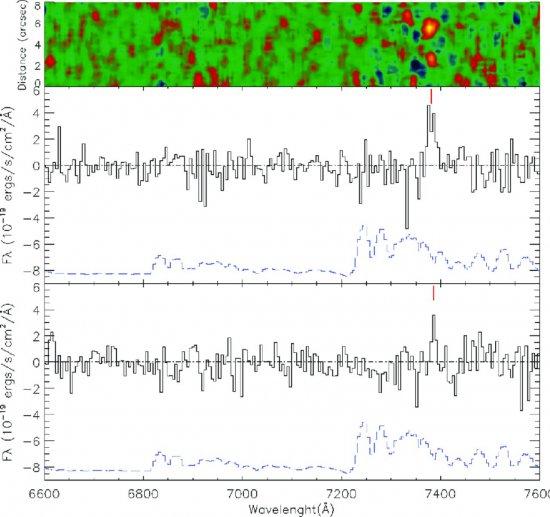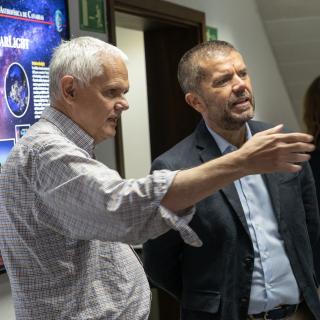To understand how the first structures in the Universe were formed, astrophysicists study the most distant galaxies. These galaxies, which are very difficult to observe, can be recognized because the spectral lines of their chemical elements are strongly shifted to the red (high values of the “z” parameter). This is the case of the two primitive galaxies (at z = 5.7, which is equivalent to observing them as they were 12,550 million years ago; the present age of the Universe is 13,700 million years) recently observed and analyzed by a team of researchers at the Instituto de Astrofísica de Canarias (IAC) and the Universidad de La Laguna (ULL), using data from the OSIRIS spectrograph on the 10.4m Gran Telescopio CANARIAS (GTC) at the Roque de Los Muchachos Observatory, La Palma.
The two galaxies, which are very close together and are in interaction with a third galaxy, have had at least two bursts of star formation, one of them 100 million years ago, and a more recent burst only two million years old. Contributing to this study, which has just been published in the journal MNRAS Letters, were researchers from the Universidad Complutense de Madrid, and the Centro de Astrobiología (CSIC-INTA). There were also constributions from researchers at the University of Geneva, the public company GRANTECAN, the Instituto de Astrofísica de Cantabria (CSIC-UC) and the University of Bochum , Germany.
Astronomical archeology
The theoretical model presently in vogue, which explains how galaxies formed (the “hierarchical model”), hypothesises that the largest galaxies formed as a consequence of the merger of smaller galaxies. In these processes, often violent, there may be strong bursts of star formation, which contribute to the generation of the newer larger, more massive galaxies than their progenitors.
In recent decades there has been great progress in the study of distant galaxies, thanks to the improved instrumentation on the largest telescopes, and new observing techniques. Even so, a key question which has not been well studied is the nature of star formation in these primitive galaxies. Most previous studies have assumed that the stars formed continuously, gradually using up the gas in the galaxy as this was converted to stars.
Distant galaxies are the objectives of the project SHARDS (Suvery of high-z Absorption of Read and Dead Sources). SHARDS is an ESO/GTC project, which was approved in 2009 (see the press release at: http://www.iac.es/divulgacion.php?op1=16&id=712). The aim of the project is to detect tens of thousands of galaxies over a range of distances, and via detailed study try to understand in greater depth how galaxies have formed during the life of the Universe.
“However, SHARDS can also be used to find galaxies with emission lines. Among these we have picked out two galaxies really near to one another which appear to be in mutual interaction, and also interacting with a third galaxy” says José Miguel Rodríguez Espinosa, researcher at the IAC/ULL, and first author of the published article.
The OSIRIS spectrograph on the GTC has given us the confirmation of a redshift of the two galaxies close to z = 5.07, using the detection of its Lyman-alpha emission (radiation emitted by hydrogen when it is ionized by highly energetic sources, such as youg, massive stars). This line is not easy to detect, because it can be absorbed by the clouds of interstellar gas and dust in the galaxies. Even though these objects emit very weakly, the researchers were able to detect their emission in Lyman-alpha using only two hours of observation with the GTC. Lyman-alpha emission is one of the few tracers available to study the galaxies which formed first during the history of the Universe, because of its cosmological redshift.
The combination of the spectroscopic data with multi-band photometry from the ultraviolet to the visible range has also revealed the presence of two distinct populations of stars in each of the galaxies, a very young population, without much total mass, plus an old population, responsible for the major fraction of the mass of the galaxies observed. “This is the first time-insists Rodríguez Espinosa- that episodic star formation has been detected in very early galaxies, even though it remains to be seen if this type of star formation is common in distant galaxies or whether it is due to the fact that the observed galaxies are in a process of interaction".
The article: “Episodic star formation in a group of LAES at z=5.07”, in the journal MNRAS Letters.
The authors: J.M. Rodríguez Espinosa (IAC/ULL), O. González-Martín (IAC/ULL), N. Castro Rodríguez (IAC/ULL), P.G. Pérez-González (Universidad Complutense de Madrid), J.M. Mas-Hesse (Centro de Astrobiología, CSIC-INTA), C. Muñoz-Tuñón (IAC/ULL), A. Cava (Universidad de Ginebra, Suiza), N. Cardiel (Universidad Complutense de Madrid), A. Cabrera Lavers (GRANTECAN, La Palma), J. Gallego (Universidad Complutense de Madrid), A. Hernán Caballero, (Instituto de Astrofísica de Cantabria, CISC-UC), N. Herrera Ruiz (Universidad de Bochum, Alemania) y N. Ramírez Olivencia (Universidad Complutense de Madrid).
Contact: prensa [at] iac.es (prensa[at]iac[dot]es)



